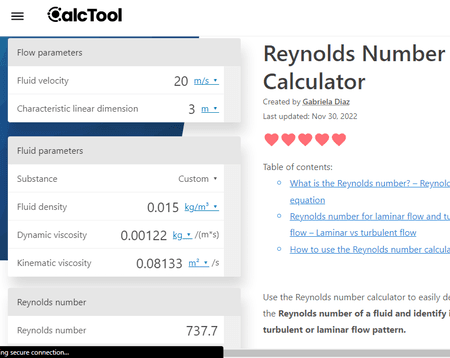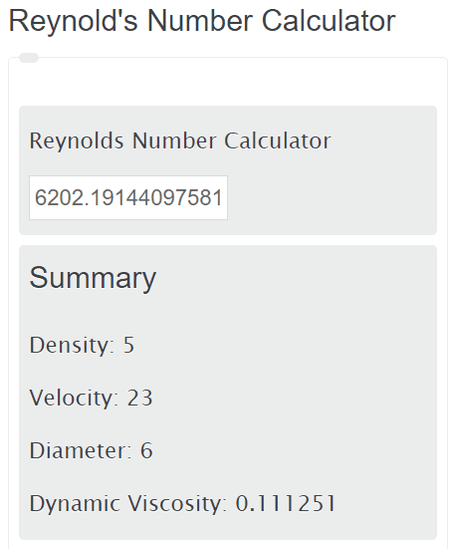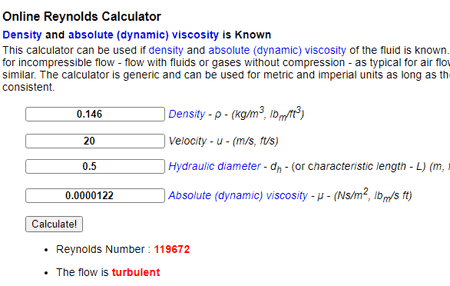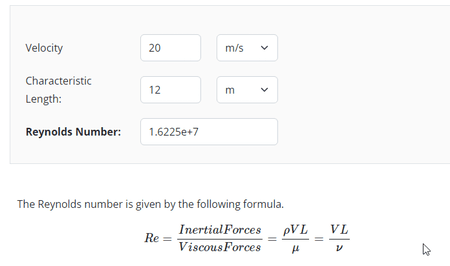20 Best Free Online Reynolds Number Calculator Websites
Here is a list of the best free online Reynolds Number Calculator websites. There are two flow properties for a liquid in fluid mechanics. One is laminar flow where the fluid flows smoothly in a regular path. And the other is turbulent flow where the fluid goes through irregular fluctuations. Reynolds number is used to predict the behavior of a fluid flow in different scenarios. Mathematically, it is defined as the ratio of inertial forces to viscous forces within a fluid.
By knowing the Reynolds number, you can easily determine whether the fluid flow is laminar or turbulent. A Reynolds number lesser than 2300 represents a typical laminar flow. Whereas, a Reynolds number greater than 4000 indicates turbulent flow. To calculate the Reynolds number, you should know the flow parameters and fluid parameters. The flow parameters cover fluid velocity and characteristic linear dimension. Whereas the fluid parameters cover fluid density and viscosity.
This post covers 20 free websites where you can calculate Reynolds number online. These websites offer online calculators where you can enter the flow and fluid parameters to calculate the Reynolds number. You can go through the list to check these out in detail.
My Favorite Online Reynolds Number Calculator
OmniCalculator.com is my favorite website on this list to calculate Reynolds number online. This calculator has a neat and well-organized interface and provides detailed theoretical information about Reynolds number and fluid flows. On top of that, it also covers a set of pre-defined substances that you can select and automatically fills the respective fluid parameters into the calculator.
You can check out our other lists of the best free online Air Density Calculator websites, online Darcy’s Law Calculator websites, and online Coterminal Angle Calculator websites.
Comparison Table:
| Name | Reynolds Number | Change Unit | Fluid Sustance Presets |
|---|---|---|---|
| OmniCalculator.com | ✓ | ✓ | ✓ |
| AllMath.com | ✓ | x | x |
| CalcTool.org | ✓ | ✓ | ✓ |
| PhysicsCalc.com | ✓ | ✓ | ✓ |
| Calculator.academy | ✓ | x | x |
| CalcTown.com | ✓ | x | x |
| EasyCalculation.com | ✓ | x | x |
| EngineeringToolbox.com | ✓ | x | x |
| AirFoilTools.com | ✓ | x | x |
| AeroToolbox.com | ✓ | ✓ | ✓ |
| EngineeringClicks.com | ✓ | ✓ | x |
| Hydraulic-Calculation.com | ✓ | x | ✓ |
| Byjus.com | ✓ | x | x |
| eFunda.com | ✓ | ✓ | x |
| Calistry.org | ✓ | ✓ | x |
| PipeFlowCalculations.com | ✓ | ✓ | ✓ |
| CalculatorEdge.com | ✓ | x | x |
| IFMServices.com | ✓ | x | x |
| AJDesigner.com | ✓ | ✓ | x |
| FlowMeterDirectory.com | ✓ | ✓ | x |
OmniCalculator.com

OmniCalculator.com is a website that offers a wide collection of online calculators across various categories. It has a free online Reynolds Number Calculator. You can use this calculator to find the Reynolds number of any flowing fluid. It has two input sections; one for flow parameters and one for fluid parameters. You can simply add your data to get the Reynolds number. The fluid parameters section has a collection of common substances. You can simply select a substance from the list and it automatically fills in the fluid parameters for that. Alternatively, you can go with the custom option and add the fluid parameters manually to get the Reynolds number.
How to calculate Reynolds Number on OmniCalculator?
- Go to this calculator on OmniCalculator using the direct link given below.
- Enter the Fluid velocity and characteristic linear dimension with the correct unit selected.
- Then add the Fluid parameters and select the substance.
- This gets you the Reynolds number.
Additional Features:
- It offers a preset of common substances that you can select to auto-fill the fluid parameters.
- It generates a link to share the results.
AllMath.com

AllMath.com is a free website that offers converter and calculator tools to make math easier. It has a free online Reynolds Number Calculator. To calculate the Reynolds Number, you have to add the values of Density, Velocity, Characteristic Length, and Viscosity into the calculator. The units for all these four parameters are fixed. So you have to add the values as per the mentioned units. With that, you can get the Reynolds Number for your parameters.
How to calculate Reynolds Number on AllMath?
- Visit this Reynolds Number Calculator on AllMath using the link given below.
- Make sure the calculator is set to calculate Reynolds Number.
- Then enter the required parameters as per the written units into the calculator.
- After that, click the Calculate button to get the Reynolds number.
CalcTool.org

CalcTool.org is similar to OmniCalculator. It has the same Reynolds Number Calculator that you can use to calculate the Reynolds Number of a flowing liquid. To do that, you have to provide the flow parameters including fluid velocity and characteristic linear dimension. Along with that, you also have to provide the fluid parameters. You can add the fluid density and viscosity manually. Or, you can select a liquid from the substance list to automatically fill the fluid parameters. As you fill in the parameters, the calculator gives you the Reynolds Number in the output.
How to calculate Reynolds Number on CalcTool?
- Use the direct link given below to open this calculator in your browser.
- Add the flow parameters into the calculator.
- Then select the fluid substance or fill in the fluid parameters manually.
- When you do that, it gets you the Reynolds Number.
Additional Features:
- This calculator has a list of substances and automatically fills the fluid parameters as per the selected substance.
- It supports multiple measurement units and allows you to change as per the input values.
PhysicsCalc.com

PhysicsCalc.com has a free online Reynolds Number Calculator. This calculator comes with a set of fluid substances that you can pick for your calculation. When you pick a substance, it automatically fills in the fluid density and viscosity. And if you are dealing with a different substance or condition, you can fill in the fluid parameters manually as well. Then you can simply add the flow parameters covering fluid velocity and characteristic length to get the results. You have to scroll down to the section where it explains the formula. It shows the results after the formula.
How to calculate Reynolds Number on PhysicsCalc?
- Use the direct link provided below to open this calculator.
- Select Find Reynolds Number under the Choose a Calculation section.
- Then, select the fluid under the Gas dropdown. Or you can manually enter the fluid parameters.
- Enter the flow parameters with the correct unit into the calculator.
- Then click the Calculate button to get the Reynolds Number.
Additional Features:
- This calculator covers a list of common fluids that you can select from. When you do that, it automatically fills in the fluid parameters for that.
- It also lets you change the unit of each parameter accordingly.
Calculator.academy

Calculator.academy is another free website that offers a wide collection of online calculators. It has a free online Reynolds number calculator that you can use. This is a simple calculator that asks for Density, Velocity, Diameter, and Dynamic Viscosity. You can simply add these four parameters into the calculator and get the Reynolds number in the output. The web page also covers the Reynolds number formula along with examples.
How to calculate Reynolds Number on Calculator.academy?
- Open this calculator using the direct link given below.
- Enter the required parameters into the calculator.
- Then click the Calculate button to get the respective Reynolds number.
CalcTown.com

CalcTown.com is another free website with an online Reynolds number calculator. This website offers a simple calculator where you can add your input parameters and calculate the Reynolds number. The calculator here has four input parameters covering the Diameter of Pipe, Diameter of Pipe, Viscosity of Fluid, and Fluid Velocity. Each parameter has a pre-defined measuring unit that you can not change. So you have to enter the correct values as per the defined unit for each parameter. With that, you can calculate the Reynolds number using this calculator.
How to calculate Reynolds Number on CalcTown?
- Follow the link given below to open this calculator in your browser.
- Enter the values of the required parameters into the calculator.
- Then click the Calculate button to get the Reynolds number.
EasyCalculation.com

EasyCalculation.com offers a versatile Reynolds number calculator. This calculator requires Density, Velocity, Characteristic Length, and Viscosity to calculate the Reynolds number. At the top of the calculator, there is a dropdown option where you can select what you want to calculate. You can set it to Reynolds numbers and add the required parameters to get that. Alternatively, if you already know the Reynolds number, you can select the parameters you want to calculate and enter the other values to find that missing parameter.
How to calculate Reynolds Number on EasyCalculation?
- Follow the link provided below to access this calculator directly.
- At the top, select I want to calculate “Reynolds Number” in the dropdown.
- Then enter the values of the required parameters in the mentioned units.
- After that, click the Calculate button to get the Reynolds number.
Additional Features:
- This calculator can be used to calculate Reynolds Number or any other parameters involved.
EngineeringToolbox.com

EngineeringToolbox.com is another free website with a free online Reynolds number. The web page covers two Reynolds numbers. The first calculator calculates the Reynolds number when the Density and absolute (dynamic) viscosity is Known. And the other calculator calculates the Reynolds number when the Kinematic viscosity is known. Depending on what parameters are known to you, you can use either of the calculators to find the Reynolds number. Both these calculators required the parameters in specific measurement units. But that is not an issue as it also offers a unit converter for each of those parameters. You can use that to convert the unit and then use the calculator to find the Reynolds number.
How to calculate Reynolds Number on EngineeringToolbox?
- Follow the link given below to lead this online calculator.
- Scroll down to the Online Reynolds Calculator section.
- Enter the required parameters into that calculator.
Then click the Calculate button to get the result.
Additional Features:
- This web page has another Reynolds number calculator that you can use when the Kinematic viscosity is known.
- It offers a sidebar to easily convert the measurement unit of each parameter involved.
AirFoilTools.com

AirFoilTools.com offers a simple online Reynolds number calculator. This calculator calculates the Reynolds number from Velocity, Chord width, and Kinematic Viscosity. Alongside the calculator, it lists the Kinematic Viscosity of air and water at different temperatures. If those are your fluid substance then you can get the value of Kinematic Viscosity from there. Otherwise, you can enter your values and calculate the Reynolds number.
How to calculate Reynolds Number on AirFoilTools?
- Go to this calculator using the direct link given below.
- Enter the values of Velocity, Chord width, and Kinematic Viscosity.
- After that, click the Calculate button to calculate the Reynolds number.
Additional Features:
- This calculator lists the Kinematic Viscosity of air and water at different temperatures.
AeroToolbox.com

AeroToolbox.com has a free online Reynolds number calculator. This calculator comes with two calculation modes; Standard Atmosphere and Manual Calculation. The Standard Atmosphere mode automatically fills the Density and Velocity into the calculator. Whereas the Manual Calculation mode takes user inputs. Along with that, you can also toggle to use Kinematic Viscosity instead of Density and Velocity. You can simply add the required parameters into the calculator and calculate the Reynolds parameters.
How to calculate Reynolds Number on AeroToolbox?
- Use the link given below to open this calculator in your web browser.
- Select between Standard Atmosphere and Manual Calculation from the top.
- Then select the correct unit for each required parameter and enter the respective values.
- When you fill all the required fields, it automatically calculates the Reynolds number.
Additional Features:
- This calculator has two modes; one for Standard Atmosphere where it auto-fills the fluid parameters and another for Manual Calculation.
- It lets you easily change the unit used for the input parameters.
EngineeringClicks.com

EngineeringClicks.com is another free website where you can calculate the Reynolds number online. This website offers a simple calculator that calculates the Reynolds number from Density, Velocity, Viscosity, and Characteristic distance. You have the option to select the desired unit for each of these parameters. Then you can simply add your respective values and use the calculator to get the Reynolds number.
How to calculate Reynolds Number on EngineeringClicks?
- Go to the link given below to access this calculator.
- Scroll on the resulting page, till you get to the calculator.
- Select the correct unit and enter the required parameters into the calculator.
- Then use the Calculate button and get the value of the Reynolds number.
Additional Features:
- This calculator allows you to select the desired measurement unit for the input parameters.
Hydraulic-Calculation.com

Hydraulic-Calculation.com is another free website with a free online Reynolds number calculator. This calculator calculates the Reynolds number for Kinematic viscosity. It has a list covering the Kinematic viscosity of commonly used substances. If your substance is listed there then you can pick it up directly. Otherwise, you can manually define the Kinematic viscosity of your calculation. Then you can add the Velocity and Pipe Diameter to get the Reynolds number.
How to calculate Reynolds Number on Hydraulic-Calculation?
- Use the direct link given below to open this calculator.
- Enter the values of Velocity and Pipe Diameter into the calculator.
- Then select the substance or enter the Kinematic viscosity manually.
- After that use the Calculate button to get the Reynolds number.
Additional Features:
- This calculator lists the Kinematic viscosity of various commonly used substances.
Byjus.com

Byjus.com is an e-learning platform that provides educational resources and tools online. It has a free online Reynolds number calculator. This is a simple calculator that calculates the Reynolds number from Density, Flow Rate, Viscosity, and Diameter. It has the specific unit mentioned alongside each of these parameters. You have to provide the values of all these four parameters in the mentioned unit. After that, you can use the calculator to calculate the Reynolds number from that.
How to calculate Reynolds Number on Byjus?
- Follow the link given below to access this online calculator directly.
- Provides the values of required parameters in the respective section.
- Then click the Submit button to get the Reynolds number.
eFunda.com

eFunda.com is another website with a simple online Reynolds number calculator. This calculator lets you calculate the Reynolds number from the Free-stream fluid velocity, Characteristic distance (or pipe diameter), Fluid density, and Fluid viscosity. It lets you change the measuring unit for these parameters so you can add the correct input as per your data. With that, you can use the calculator to find the Reynolds number.
How to calculate Reynolds Number on eFunda?
- Go to this calculator using the direct link given below.
- Select the correct unit and enter the required parameters into the calculator.
- Then click the Calculate button to get the Reynolds number.
Additional Features:
- You can change the unit of each input parameter as per your data.
Calistry.org

Calistry.org offers a simple yet versatile online Reynolds number calculator. This calculator has five fields for Reynolds number, diameter or length, the density of the fluid, the velocity of the object, and the Viscosity of the fluid. Below each input field, you get a dropdown section where you can pick the desired unit for that parameter. You can add any four parameters into the calculator and calculate the missing parameter. This way, you can use it to find Reynolds numbers. And when the Reynolds number is known to you, you can use the calculator to find other missing parameters as well.
How to calculate Reynolds Number on Calistry?
- Use the link provided below to directly access this online calculator.
- Enter your input values into the calculator. Make sure the correct measuring unit is selected for each value.
- After that, click the Re button to calculate the Reynolds number. Similarly, you can also calculate other parameters.
Additional Features:
- This calculator allows to change the measuring units for the input parameters.
- You can use this calculator to find another missing parameter when the Reynolds number is known.
PipeFlowCalculations.com

PipeFlowCalculations.com has a comprehensive online Reynolds number calculator. This calculator has three separate sections for Flow rates and velocity, Pipe dimensions, and Fluid properties. The Flow rates and velocity section takes the volume flow rate and calculates mass flow rate, and velocity. The Pipe dimensions section asks for the pipe diameter and calculates the cross-section from that. It also lists standard pipes that you can select to automatically fetch the pipe dimensions. Lastly, the Fluid properties section asks for density and kinematic viscosity. It also includes a list of standard fluids that you can select as per your case. Or you can just add the parameters manually and get the Reynolds number for that.
How to calculate Reynolds Number on PipeFlowCalculations?
- Open this calculator in your browser using the link given below.
- Enter the value of the volume flow rate into the calculator.
- Then in the Pipe dimensions section, select a standard pipe or manually enter the pipe diameter.
- Similarly, in the Fluid Properties section, select a standard fluid from the list or manually enter the fluid properties.
- When you fill in all the required parameters, the calculator shows you the Reynolds number for that.
Additional Features:
- This calculator provides a set of pre-defined standard pipe diameters as well as fluid properties.
- It also lets you switch the measuring unit for the parameters.
CalculatorEdge.com

CalculatorEdge.com has a simple Reynolds number calculator. This calculator calculates the Reynolds number from fluid properties covering the Viscosity of Substance and Velocity. Along with that, you have to provide the Diameter of the pipe along with the Specific Weight of the Substance. You have to provide these parameters in specific measuring units that you can not change. With that, the calculator calculates the Reynolds number for your inputs.
How to calculate Reynolds Number on CalculatorEdge?
- Follow the link given below to open this calculator in your browser.
- Enter the values of the required parameters into the calculator.
- Then click the Calculate button to get the respective Reynolds number.
IFMServices.com

IFMServices.com has a free online calculator that calculates Reynolds number from kinematic viscosity. It has a simple interface where you have to add the values of flow rate, pipe diameter, and kinematic viscosity in pre-selected units. Along with that, you also have to enter an email address to perform the calculation. After that, the calculator gives you the Reynolds number for your data. Based on that, it also tells you the state of the flow of the fluid.
How to calculate Reynolds Number on IFMServices?
- Follow the link given below to open this calculator.
- Enter the flow rate, pipe diameter, and kinematic viscosity along with your email address.
- Then click the Calculate button to get the Reynolds number.
AJDesigner.com

AJDesigner.com is another website that you can use to calculate Reynolds numbers online. This website offers a simple calculator that explains the Reynolds number along with the formula. Then it has four input fields asking for density, velocity, characteristic length, and viscosity. You can pick the unit for each parameter and enter your values. Then you can run the calculator to get the Reynolds number.
How to calculate Reynolds Number on AJDesigner?
- Open this calculator in your browser using the direct link given below.
- Enter the required parameters and make sure you selected the correct units for your data.
- Then click the Calculate button to get the Reynolds number for your calculation.
Additional Features:
- You can pick the measurement unit for the input data.
FlowMeterDirectory.com

FlowMeterDirectory.com has a simple online Reynolds number calculator. This calculator determines the Reynolds number of fluid from diameter/distance, fluid velocity, fluid density, and viscosity. You have to provide the values of these four parameters in the calculator. Each parameter has a dropdown section alongside where you can choose the correct unit as per your values. Then you can simply add the values and calculate the Reynolds number for the added data.
How to calculate Reynolds Number on FlowMeterDirectory?
- Use the link added below to visit this calculator online.
- Select the correct measuring unit for each parameter and add your values.
- Then click the Calculate button to get the Reynolds number.
Additional Features:
- This calculator allows you to set the measuring unit for each input parameters.
- It explains the laminar and turbulent flow using diagrams.
Frequently Asked Questions
Reynolds number is a dimensionless quantity used in fluid mechanics to predict flow patterns in different types of fluids. It is calculated as the ratio of inertial forces to viscous forces in a fluid flow.
Reynolds number is calculated by dividing the product of the fluid velocity, characteristic length, and fluid density by the fluid viscosity. It is expressed as Re = (ρvl)/μ, where Re is the Reynolds number, ρ is the fluid density, v is the fluid velocity, l is the characteristic length, and μ is the fluid viscosity.
Reynolds number is used in fluid mechanics to predict the flow patterns of different types of fluids, such as laminar or turbulent flow. It helps to determine the onset of turbulence and can be used to design and optimize fluid flow systems.
The Reynolds number for laminar flow is typically less than 2300. However, the exact value of the Reynolds number at which laminar flow transitions to turbulent flow can vary depending on the geometry of the system, the properties of the fluid, and other factors.
About Us
We are the team behind some of the most popular tech blogs, like: I LoveFree Software and Windows 8 Freeware.
More About UsArchives
- May 2024
- April 2024
- March 2024
- February 2024
- January 2024
- December 2023
- November 2023
- October 2023
- September 2023
- August 2023
- July 2023
- June 2023
- May 2023
- April 2023
- March 2023
- February 2023
- January 2023
- December 2022
- November 2022
- October 2022
- September 2022
- August 2022
- July 2022
- June 2022
- May 2022
- April 2022
- March 2022
- February 2022
- January 2022
- December 2021
- November 2021
- October 2021
- September 2021
- August 2021
- July 2021
- June 2021
- May 2021
- April 2021
- March 2021
- February 2021
- January 2021
- December 2020
- November 2020
- October 2020
- September 2020
- August 2020
- July 2020
- June 2020
- May 2020
- April 2020
- March 2020
- February 2020
- January 2020
- December 2019
- November 2019
- October 2019
- September 2019
- August 2019
- July 2019
- June 2019
- May 2019
- April 2019
- March 2019
- February 2019
- January 2019
- December 2018
- November 2018
- October 2018
- September 2018
- August 2018
- July 2018
- June 2018
- May 2018
- April 2018
- March 2018
- February 2018
- January 2018
- December 2017
- November 2017
- October 2017
- September 2017
- August 2017
- July 2017
- June 2017
- May 2017
- April 2017
- March 2017
- February 2017
- January 2017
- December 2016
- November 2016
- October 2016
- September 2016
- August 2016
- July 2016
- June 2016
- May 2016
- April 2016
- March 2016
- February 2016
- January 2016
- December 2015
- November 2015
- October 2015
- September 2015
- August 2015
- July 2015
- June 2015
- May 2015
- April 2015
- March 2015
- February 2015
- January 2015
- December 2014
- November 2014
- October 2014
- September 2014
- August 2014
- July 2014
- June 2014
- May 2014
- April 2014
- March 2014








